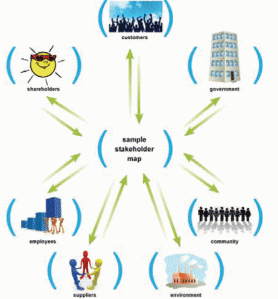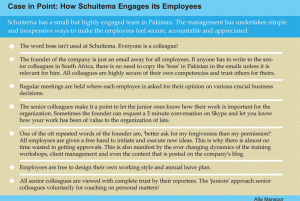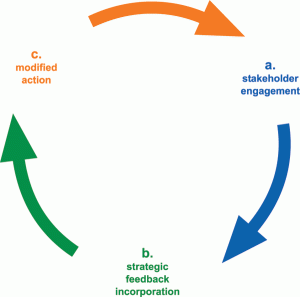With all this talk about stakeholder ‘management’, subconsciously, our brains tend to process stakeholders as yet another nuisance to be ‘managed’. Managing humans, to me, has somewhat of a negative connotation. Of course, when displeased, stakeholders could present a risk to be mitigated. However, when meaningfully engaged and consulted, there is much latent energy to be shared through meaningful relationships.
This, is the angle we’d like to explore through the current tbl theme on stakeholder engagement.
Rewind
Who, are stakeholders?
The simple definition (the way that I like to see stakeholders) is: those individuals who are influenced by an organization or company’s processes or products and, in turn, influence the organization or company. Google will turn up some fancier definitions for you if complexity’s your fancy.
And, if you think about it, even voiceless entities, such as the environment, are considered key ‘stakeholder’ groups. There are also many ‘speakers’ on behalf of the environment, for instance, who then work together to help such stakeholder groups’ voice be heard and understood.
Why? The Business Case
If CSR is about minimising negative and maxi-mising positive environmental and social impacts, then stakeholder engagement (SE) is one of the core activities which enables this to happen, successfully according to Professor David Grayson, Director of Cranfield University’s Doughty Centre for Corporate Responsibility.
“Organizations can no longer choose if they want to engage with stakeholders or not; the only decision they need to take is when and how successfully to engage” he says, and goes on to warn: “Stakeholder engagement is crucially different from stakeholder management”. Don’t we wish everyone had the same sensitivity regarding the implications of linguistic choices!
“Stakeholder engagement implies a willingness to listen; to discuss issues of interest to stakeholders of the organization,” he further goes on to say. And, perhaps most importantly, it implies the willingness to honestly consider change as a result of stakeholder engagement.
Successful stakeholder engagement, Grayson says, becomes “the art of optimising long term benefits for the organization based on reconciling sometimes disparate stakeholders’ wants and needs”.
And the negative repercussions of disengagement, on the other hand, can be much less forgiving, ranging from undesirable vindictive headlines to factory shutting community riots. Ask organizations who face hostile communities or unfamiliar NGOs’ campaigns: from their million-dollar operational interruption losses to fading customer loyalty, they know very well the importance of nurturing stakeholder relationships.
Moreover, understanding the dynamics behind stakeholder behaviour is perhaps even more relevant in a developing country context such as Pakistan’s. Such embroiled surroundings offer higher stakes, both in terms of opportunity realization and risk mitigation. Understanding one’s organization’s stakeholder groups is the first step towards being in a state of proactive preparedness and positioning oneself for success (and away from disaster).
What?
But before we delve deeper, a quick revisit to what we really mean by stakeholder engagement:
Again, different minds focus on different nuances of the concept. Generally, stakeholder engagement is considered a strategic tool for building partnerships, based upon truthfulness, transparency and trust. Partnerships with? All primary stakeholders of course: parties that most influence or are influenced by the organization.
SE specialist Rick Jones, in his paper entitled, ‘Stakeholder Engagement in Practice: Now is the Time to Act!’ highlights that key and recurring features of effective stakeholder engagement include: being proactive, open and inclusive, honest, responsive, and transparent, using two-way dialogue.
Stakeholder engagement can be most beneficial in decision making: It leads to informed and sustainable decisions that are implemented effectively because of the broad support created by the engagement process, Jones adds.
Note that, like most effective longterm tools (especially within the CSR space), Stakeholder Engagement is also process oriented. The ‘outcomes’ or ‘goals’, such as CSR Reports or Stakeholder Engagement Reports, are milestones achieved by default when the SE processes are effectively stewarded. When focused on as a deliverable mostly divorced of the learnings of the process, the positive impact is minimized or worse still, negated. In SE, the means is in itself a large part of the end. This is vital to understand.
How?
Every organization must begin with recognising the importance of business impact of stakeholder views’ and thus of stakeholder engagement. Without the understanding that stakeholder engagement directly impacts short and long-term business success, SE will continue to be treated as an add-on with its positive potential remaining unleveraged.
1. Stakeholder Mapping
Start off with a stakeholder mapping exercise. This process commences as a simple listing of all potential groups that exert influence over, or are influenced by an organization’s action.

As the Stakeholder Map illustrates, key stakeholders of many industries’ and sectors, are similar. Primary stakeholders will inevitably include employees, shareholders, customers, local communities, suppliers, the environment.
The prioritization of each group, and parties within each group, will of course vary with industry, company and context. Each company must remain dynamic, prioritizing stakeholders as times and issues evolve.
2. Understanding the Gaps
So, what are the key steps leading from the identification of stakeholders and the ensuing reflex of an oft-‘unprepared’ initiation of conversations and interactions?

We must not shy away from appreciating the fact that the fundamental motivation of each side in any stakeholder engagement may differ significantly. But understanding and articulating this very difference, Grayson points out, can help close the gap. Each party should ideally understand and transparently articulate their motivation.
Taking the time and making the effort to fully comprehend stakeholders’ needs and wants (SWANS) will help lay the foundation for trust and understanding – critical first steps of a meaningful SE process.
Upon this foundation, organizations can then move towards effectively Identifying, Under-standing and Incorporating (IUI-ing) opportunities and challenges towards building beneficial stakeholders relationships. (Notice the acronym’s unabashed sandwiching of the ‘other’, U, with the self, ‘I’.)
This stakeholder mapping and gap-identification process can often be kicked off by independent third-parties. In fact, in industries that are trying to learn from and overcome potentially negative baggage, the initial engagement is best carried by a transparently neutral party to help stakeholders be more open in their initial communication.
Uplifting news: there are companies and organizations in Pakistan, as in other emerging countries, progressive enough to realize this need and undertake it bold first steps. Admittedly, they may be progressive because they’ve already learnt some lessons the hard way. Others are of course, impressively proactive in undertaking this process of self awareness and analysis. In the longer term, how many of these local trailblazers actually harness the invaluable insights from SE-based initiatives, will represent the true fruition.
3.Then What?
How effective this gap analysis is, is proportionate to soliciting organizations’ willingness to take action based on stakeholder feedback. Its usefulness is of course inversely proportionate to organizations’ resistance to criticism.
Thus, the ‘stakeholder engagement ‘ strategy incorporation ‘ revised action loop should form an ongoing part of an organization’s management approach.
The universal SE process really can be as simple as that: a,b,c – provided organizational intent is in sync with the endeavour. For instance, the basic compass for this ongoing loop could be balancing Grayson’s catchy (SWANS) with the organization’s wants and needs (OWANS).

The Right Medium
Next, sensibly tailoring any stakeholder engagement mechanism to the particular group’s ground realities cannot be emphasized enough. For instance, a CSR report cannot be considered an engagement tool towards communicating with both the value chain’s suppliers and customers, and internal employees, and the community.
To fully benefit from SE, organizations must make the effort to engage each group within their comfort zone [the stakeholder group’s, not the organization’s!]. The right medium for the right group: for instance, community council visits for engaging local community leaders; or 1-page briefs prepared for Board meetings; or even something simple like email memos or pages within the corporate news-letter for engaging internal stakeholders.
The more we invest in ensuring the meaningfulness of the process to all parties, the more we’ll get out of it. And when it comes to SE, both the form and the substance together will shape the right package.
When?
The simple answer: regularly. This is not a tick-box, one-off event to be ‘managed’.
Just remember not to OD on SE. Stakeholders can tire of ‘being consulted’. Being called to focus groups, or random visits by organizational representatives are welcome – to a limit. We don’t want to cause ‘stakeholder fatigue’ with unnecessary overzealousness.
Moreover, SE that doesn’t result in appropriate modified action loops can be more dangerous than beneficial leading stakeholders to discount any engagement measures as a fade for shallow, self-imagining initiatives. Opening a whole new can of worms.
This of course doesn’t mean that organizational willingness to listen to stakeholders translates into surrendering to external pressures. Organizations’ leadership still needs to set the direction for its growth – doing so by knowing and balancing both “stakeholders’ wants and needs (SWANS) as well as the organization’s wants and needs (OWANS)”, as Grayson put it.
The good news is that Stakeholder Engagement is one of those CSR spaces that has been widely internalized by a variety of disciples: From the Project Management industry’s SRMM (Stakeholder Relationship Management Maturity) approach based on the Stakeholder Circle methodology, to marketing gurus predicting that CRM will shift to SRM (from Customer Relationship Management to Stakeholder Relationship Management). Those at the cutting edge of most functions no longer feign that long term prosperity is possible in isolation from a comprehensive group of stakeholders.
My own favourite guiding principle of inclusivity is becoming a much more inherently embraced concept even by those not within the direct Sustainability realm.
And so the silo-ed management approach is on its way to becoming history.
Welcome on-board!







Thank you, Dr. Hopkins! Positive feedback is always encouraging…
Brilliant article..well done Khadeeja